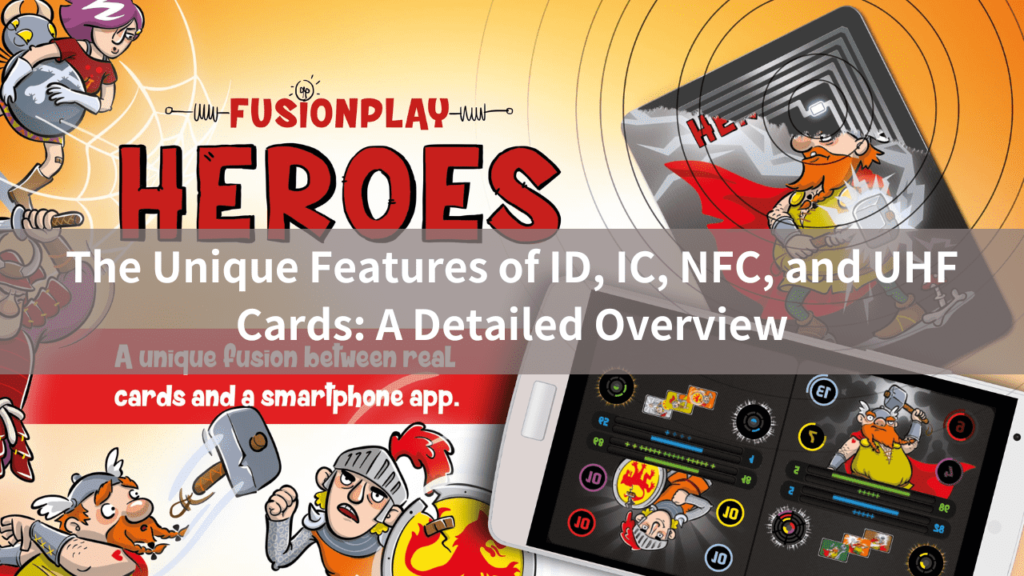
Are you familiar with RFID smart cards?
If you are still relatively unfamiliar, don’t worry, because today we will introduce you to all the knowledge of RFID smart cards in detail.
RFID smart cards may sound a bit complicated, but if I mention IC cards or ID cards, you might have some understanding. This is because ID cards and IC cards are the two most common types of RFID smart cards. However, RFID smart cards are not limited to these two types, they also include some other types.
Radio frequency communication standards are an important basis for tag chip design. At present, the communication standards related to RFID mainly include: ISO/IEC18000 standard (covering 125KHz, 134 KHz, 13.56MHz, 433MHz, 860-960MHz, 2.45GHz and other frequency bands, a total of 7 parts), ISO11785 (low frequency), ISO/IEC14443 standard (13.56MHz), ISO/IEC15693 standard (13.56MHz), EPC standards (including Class0, Class1 and GEN2 protocols, covering HF and UHF two frequency bands), and DSRC standards (European ETC standards, including 5.8GHz).
RFID is the general term for radio frequency technology systems, and RFID cards are radio frequency cards, which contain frequency sensing chips inside, which can be IC or ID chips. At present on the market, we can divide radio frequency cards into the following types according to frequency: low frequency cards (ID cards 125KHz), high frequency cards (IC cards 13.56MHz), and ultra high frequency cards (915MHz). In our daily life, most membership cards belong to IC cards, such as bus cards, meal cards, access control cards, etc., these cards can be IC cards, or they can be ID cards.
The difference between IC cards and ID cards lies in the chips contained in the card, but from the outside, they are almost indistinguishable, IC chips belong to high frequency, and ID chips belong to low frequency. The difference is that the ID card only has an ID number, while the IC card has the functions of value storage and confidentiality, which the ID card does not have.
ID badges and cards are early electronic tags, only have an ID number, cannot store any data, so they are called ID cards. Because ID cards have no algorithm and cannot write data, their ID is written once at the time of manufacture, and the user can only read the card number. Because ID cards are easy to copy, their security is low. Mainly used in access control systems and company badges.
IC badges and cards are the general term for smart cards, with readable and writable memory, also known as memory cards, logic encryption cards. The data reading and writing of IC cards require password authentication, data can be partitioned, different areas are used for different functions, can have different password protection. The content of the IC card can be repeatedly erased, divided into contact and non-contact IC cards. There are two types of RF IC cards—Type A and Type B. The main difference lies in the depth of carrier modulation and the coding method of binary numbers.
RFID card is a general term for non-contact electronic cards/tags, including ID cards, IC cards, and NFC cards, etc. The main difference between these cards is the working frequency band. RFID can be divided into low frequency, high frequency, and ultra-high frequency according to the working frequency band. According to the characteristics of different frequency bands, it is applied to different scenes, such as animal management, personnel identification, vehicle management, asset management, smart medical, etc. Different usage frequencies will produce differences in read-write distance, data exchange speed, and anti-interference.
NFC, the full name is Near Field Communication, essentially it is a two-way exchange of information. Both NFC and RFID are based on signal transmission between two objects close to each other, but NFC technology adds point-to-point (P2P) communication function, NFC devices can find each other and establish communication connections. Both RFID and NFC belong to close-range, non-contact wireless communication technology, but they actually have a relationship of inclusion and being included. RFID technology is a technology that transmits information using radio frequency signals, mainly identifying specific targets through radio signals, while NFC is near-field wireless communication technology, the chip has the ability to communicate with each other, and has computing power. NFC evolved from RFID technology, using the high-frequency (13.56MHz) standard of RFID, but it is a two-way process. NFC has high security.
RFID smart card is a very wide field, including various types of cards such as ID cards, IC cards, and NFC cards, etc. They each have their own characteristics and uses, but they all rely on radio frequency technology to achieve information transmission and storage.
I. Low Frequency (LF) RFID Badges and Cards
Protocol: ISO 11784, ISO11785, 18000-2. Frequency band: Low frequency RFID usually operates at 125 kHz or 134.2 kHz. Reading distance: The reading distance of low frequency RFID systems is short, usually a few centimeters to several tens of centimeters. Cost: relatively low. Data transmission rate: The data transmission rate is relatively slow. Features: Strong penetration ability for metal and liquid, not easily interfered, single reading. Usage scenarios: Suitable for animal identification, access control systems, car anti-theft, AGV and other short-distance applications.
An ID card (Identification Card) is a contactless RFID tag, with a working frequency of 125kHz, only one ID number, and cannot store any data, therefore it is called an ID card. The ID card is powered by a card reader, and reads the “unique” number stored in the chip’s EEPROM. The card number is written once before the card is sealed, and cannot be changed after the card is sealed.
Passive and contactless are 2 notable features of this chip, and the radio frequency interface circuit is the key core technology. It receives radio frequency energy from the card reader, generates power and clock for the chip, and implements wireless communication between the card and the card reader through technologies such as phase shift keying and load amplitude modulation. Non-contact ID cards are convenient, fast, reliable, and widely used in various fields.
- The thickness of the ID thick card is 1.8mm, with standard card size and a portable hole, which can be screen printed, internal code sprayed, and serial number printed.
- The standard thin card thickness is 0.8mm, which can be offset printed, screen printed, photo printed, internal code sprayed, and serial number printed.
- The thickness of the non-standard thin card is 1.05mm, which can be offset printed, screen printed, internal code sprayed, and serial number printed.
Typical applications: patrol systems, attendance systems, access control systems, enterprise all-in-one card systems, vehicle management, parking lot management, etc.
Security: ID cards have no storage function, and the rights and functional operations of cardholders fully depend on the network system.
Cost: The prices of cards and card readers are relatively low.
Common production techniques: UV ink, gold bottom, silver bottom, flash gold, flash silver, hot stamping gold, hot stamping silver, hot laser gold/silver, hot mirror gold/silver, signature strip, embossed code, flat code, sprayed code, surface sanding, hole punching, laminating, packaging bags, etc.
The feature of the low-frequency radio card chip is that the reading distance is short, the read-write speed is faster, the security is higher, and the price is relatively lower, so it is widely used.
Main chips include: EM4100, EM4200, EM4205, TK4100, T5577, EM4435, EM4450, Hitag1, Hitag2, HTS256, HTS2048, HID, etc.
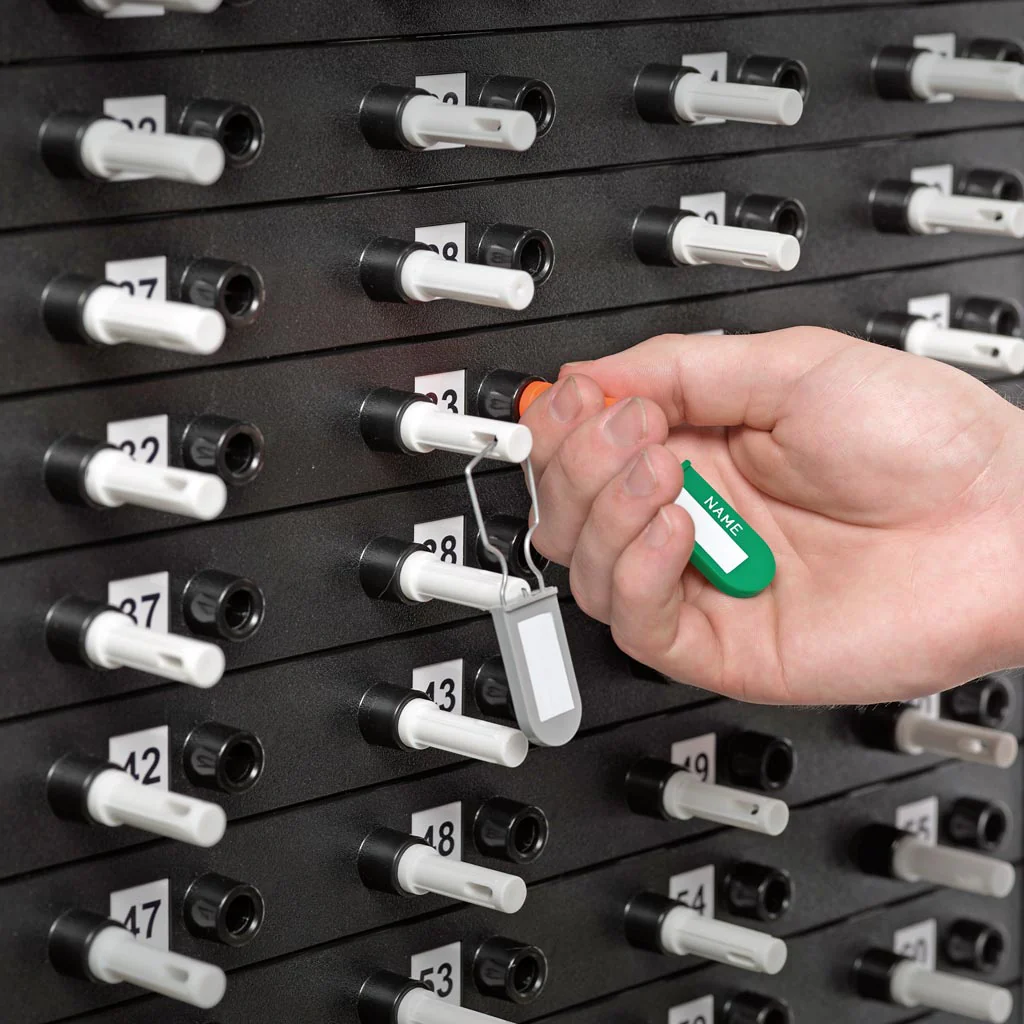
125KHz 135KHz: ISO18000-2, this is a specification for low frequency identification RFID.
- EM4100 and TK4100: These are read-only low-frequency chips. EM4469/4569: There are 11 blocks, 44 bytes, 512bit storage space.
- EM4205/4305: There are 16 sectors, 64 bytes (512bit).
- ATA5567/5577: There are 7 blocks, 28 bytes, 330bit storage space, of which 224bit is user storage space, 96bit is system storage space. ATA5567 is an upgraded product of E5550, E5551, E5554, T5557, and ATA5567 is a newly produced chip by ATMEL.
134.2KHz: ISO11784 and ISO11785, these are the specifications for animal identification RFID
- EM4005, EM4105: These low-frequency tags are used for animal identification, with appearances such as collar-style, ear tag-style, injection-style, pill-style, etc. Typical application animals include cattle, homing pigeons, etc.
- HITAG TM2: Internationally, it is usually referred to as HITAG2, produced by NXP Semiconductors in the Netherlands.
- HIAG S256: In China, it is usually referred to as HITAGA S 256.
- HITAGA S2048: In China, it is usually referred to as HITAG S 2048.
HID Card
HID cards are products of HID Corporation in the United States. HID originally started as a department within Teledyne Technologies, providing card readers and cards for the entire company. The original full name of HID was “Hughes Identification”. It became independent from Teledyne in 1991 and entered a period of continuous rapid growth in the following years. The reading TAG is “HID Prox”.
Difference between ID cards and HID cards
ID cards generally refer to read-only low-frequency cards containing EM chips or other chips (there are also read-write ones), with a frequency of 125KHz (there are also 134.2KHz frequency ones), and have a wide range of applications. The ID low-frequency card reader is the most widely circulated card reader in the market, with various transmission formats, and is almost universally compatible.
On the other hand, HID low-frequency cards are a brand of cards from HID Corporation in the United States. They don’t really have much to do with ID cards, but they are also a type of low-frequency card. It’s just that the chips they manufacture are set with a serial number by region and encrypted, so they have a custom format that is not compatible with readers of other brands, i.e., HID cards can only be used on HID card readers.
HID card formats include 26-bit, HID37-bit, Corporate 1000 Long Format, OEM format
26-bit format: H10301:
Summary: The 26-bit format is an industry standard format and also an open format. The sale of this format is not limited to a particular company. The range of card numbers provided by the 26-bit format is limited, so there is a possibility of card number duplication. HID does not guarantee that card numbers will not be duplicated, please be sure to understand this. HID does not control or limit the ordering of standard 26-bit format cards. The biggest advantage of using the standard 26-bit card format is that ordering cards is very convenient and can be used on ordinary access control boards.
Description: The 26-bit format allows up to 255 site codes. Each site code can have up to 65,535 unique card numbers.
HID proprietary 37-bit format: H10302:
Summary: HID hopes to provide an open format for the industry while ensuring unique, non-duplicating card numbers, so it developed the 37-bit format. Under this format, HID will control the issuance of card numbers, so the card numbers will not be duplicated.
Description: A wide range of non-duplicating card numbers can be coded using the 37-bit format. Although this format is available to all customers, not all access control systems can handle such large data length formats. Also, many systems cannot handle formats without site codes.
HID proprietary 37-bit format with site code: H10304:
Summary: The only difference between the 37-bit format with site code and the 37-bit format is that the former includes a site code. Like the 37-bit format without the site code, this format is also open, and card numbers will not be duplicated. HID will track the manufacturing of smart cards to prevent duplication of card numbers.
Description: This 37-bit format provides 65,535 site codes, each of which can code over half a million card numbers (up to 524,287). Many systems cannot handle the length of the 37-bit format, which is the same problem encountered by the 37-bit format without the site code. Also, many systems cannot handle site codes as large as 65,535.
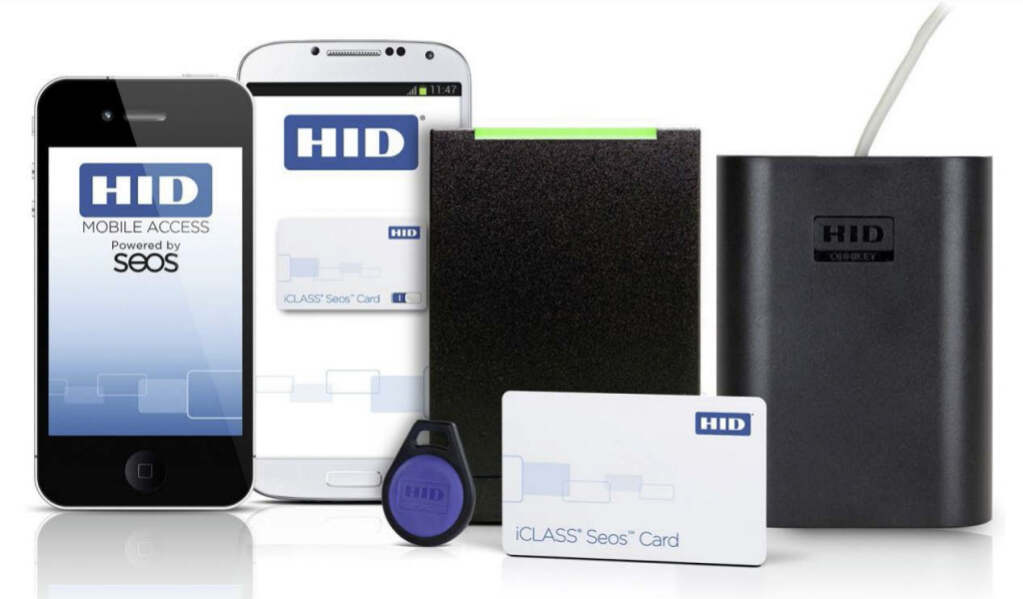
II. High Frequency (HF) RFID Badges and Cards
High-frequency RFID primarily operates at 13.56MHZ and follows protocols such as ISO7816,14443A,14443B,15693 etc. Its reading distance is slightly farther than low-frequency RFID systems, usually ranging from a few centimeters to a meter. Comparatively, its cost and data transmission rate are higher. High-frequency RFID cards are sensitive to electromagnetic interference but have good anti-collision ability, supporting group reading and single reading. The product types are rich, with storage capacity ranging from 128 bits to over 8K bytes, supporting advanced security features, from the simplest write lock to encryption, and even integrated encryption coprocessors.
They are generally used for close-range item tracking, identity recognition, library management, product management, etc. With the advancement of technology, in recent years, high-frequency CPU chip RFID cards with strong anti-copying and anti-cracking security performance have gradually replaced M1 chips, becoming the new favorite of high-frequency cards, and are gaining more and more applications.
The data read and written in the IC card requires corresponding password authentication, and even each area has different password protection, fully ensuring data security. The password for writing data to the IC card and the password for reading data can be set differently to provide a good hierarchical management method to ensure system security. IC cards can not only allow authorized users to read a large amount of data but also allow authorized users to write a large amount of data (such as new card numbers, user permissions, user information, etc.), and the content recorded by the IC card can be repeatedly erased. The security of IC cards is much greater than that of ID cards.
RFID cards are contactless electronic cards/tags, including ID cards, IC cards, NFC cards, UHF cards, and other electronic cards. Their main difference lies in the working frequency band.
ID cards are early contactless electronic tags, operating at a frequency band of 125kHz, only have an ID number, and cannot store any data, so they are called ID cards.
IC cards, if understood literally, include other RFID electronic tags and contact chip cards besides ID cards. Usually, IC cards mainly refer to contactless smart cards and contact smart cards working in the 13.56MHz frequency band. Contactless smart cards include NFC cards or tags (the NFC forum stipulates that four types of cards belong to NFC cards), and contact smart cards are smart cards with exposed chips.
RFID cards also include electronic cards/tags of other working frequency bands, such as ultra-high frequency cards 915MHz, 2.4GHz frequency bands.
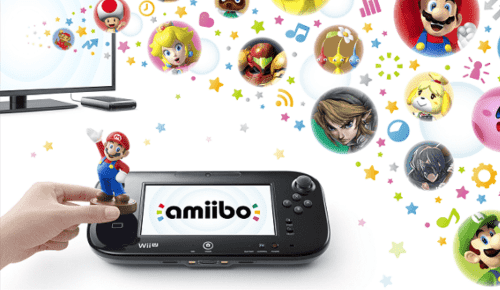
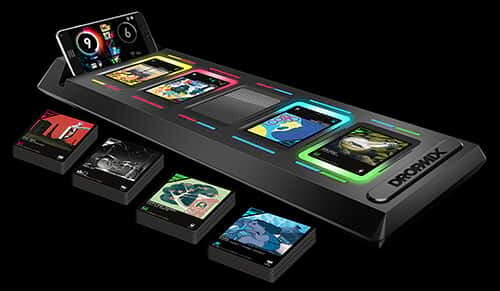
13.56MHz: ISO 14443 Types A & B, ISO 15693, ISO 18000-3 Mode 1 & 2, ISO18092 NFC, EPC HF CLASS 1, EPC HF Version 2.
(1) A simple comparison of ISO 14443 Type A and Type B protocol standards.
The international standard ISO14443 defines two types of signal interfaces: Type A and Type B. ISO14443A and B are not compatible.
ISO 14443 Type A (also known as ISO 14443A) is generally used for access cards, bus cards, and small-value stored-value consumption cards, etc., with a high market share. For example: MIFARE Ultralight (MFO ICU1X): often called U10. This chip does not have encryption function, only system encryption, memory is 64 bytes. Another: MIFARE ULtralight C, also called U20, this chip can be encrypted, memory is 192 bytes. The number of bits in the internal code of these two chips is the same, but the internal code data is different.
MIFARE Std 1k(MF1 IC S50): often called MF1 S50. Mainly used in one-card-pass. Memory 1KB, with 16 sectors, each sector has 4 blocks, each block 16 bytes. The initial password is 12 F. MIFARE Std 4k(MF1 IC S70): often referred to as MF1 S70. Mainly used in one-card-pass. Memory 4KB, a total of 40 sectors, the first 32 sectors are the same as S50, each sector has 4 blocks, the last 8 sectors are 16 blocks, each block is 16 bytes. The initial password is 12 F. Mifare DESFire 4k(MF3 IC D41/D40): commonly referred to as MF3 in China. Typical application: Nanjing Metro.
ISO14443 Type B, due to its high encryption coefficient, is more suitable for CPU cards, generally used for ID cards, passports, UnionPay cards, etc. At present, the standard adopted by China’s second-generation electronic ID card is the ISO 14443 Type B protocol. SR176: Produced by Switzerland’s STMicroelectronics (ST). SRIX4K: Produced by Switzerland’s STMicroelectronics (ST). THR1064: Produced by Beijing Tongfang. Typical application: Olympic tickets. AT88RF020: Produced by US Atmel (ATMIL). Typical application: Guangzhou Metro Card.
(2) A simple comparison of ISO 15693 protocol standards.
The read and write distance of ISO 14443A/B is usually within 10mm, with a wide range of applications. But the read and write distance of ISO15693 can reach 1m, the application is more flexible, and it is compatible with ISO 18000-3. ICODE SLI(SL2ICS20): often called ICODE 2 (memory is 1Kbit), this model is commonly used. Another: ICODE SLI-S memory is 2048bit, ICODE SLI-L memory is 512bit, these two chips are not commonly used. [Note: ICODE 1 (SL2 ICS30), often called ICODE 1, complies with ICDEI protocol, but does not comply with ISO 15693 protocol.] Tag-it HF-1 Plus: often called TI2048, produced by Texas Instruments (referred to as TI). EM4135: Produced by Switzerland’s EM. BL75R04: Produced by Shanghai Bell and FM1302T (produced by Fudan), compatible with TI’s Tag-it HF-1 Plus.
(3) ISO 18092NFC: Made some specifications for near field communication technology.
The position of NXP’s 13.56MHz high-frequency chips in the global market is unshakable, and it is the promoter of RFID chip research and development and application. The following content mainly introduces different types of chips and their application scenarios based on the NXP series of chips, which mainly include the Mifare series, NTAG series, and ICODE series.
Mifare Series Badges and Cards
MIFARE products fully comply with the ISO/IEC 14443 standard and meet the NFC Forum Type 4 tag standard. It includes the Classic, DESFire, Plus, Ultralight, SAM series, etc. Among them, the commonly used ones are S50, S70, and MIFARE Ultralight. These products are suitable for low-cost, high-traffic applications, such as public transportation, membership cards, and event tickets. The MIFARE Ultralight series of products includes three members: MIFARE Ultralight C, MIFARE Ultralight EV1, and MIFARE Ultralight Nano.
- MIFARE Ultralight C adopts the 3DES encryption standard for chip authentication and data access. Tickets, coupons, or tags based on NXP Mifare Ultralight C can be used as one-way bus tickets, event tickets, or low-cost membership cards.
- MIFARE Ultralight EV1 is the next-generation smart card IC, suitable for applications that use paper tickets and have simple uses. It has a built-in “source check” function, provides effective cloning protection, and can prevent the use of fake tickets. This integrated circuit has two memory options: 48 bytes and 128 bytes.
- MIFARE Ultralight Nano is the new generation of smart paper ticket IC in the MIFARE Ultralight series. Its innovative contactless technology is suitable for disposable applications, aiming to replace magnetic strips, barcodes/QR codes, and standard paper printed tickets.
NTAG Series Badges and Cards
NXP’s NTAG series complies with the NFC Forum Tag Type 2 and ISO/IEC14443 Type A specifications, ensuring universal interconnectivity with NFC devices (such as mobile phones, tablets, and fixed card readers). The NTAG series provides different storage capacities and special functions, and users can choose cost-effective capacity and functions for specific applications. The current products include the NTAG for smart implants and tags, and the NTAG for smart electronic devices.
- NTAG (NTAG21x series): This passive power supply IC solution seamlessly operates with NXP NFC reader IC, and this IC is widely used in more than 90% of mobile phone models equipped with NFC. It has good RF performance, various memory sizes, and smart built-in functions – ready for the next generation of implants and tags. The commonly used NTAG21x series products are subdivided into NTAG210, NTAG212, NTAG213, NTAG215, NTAG216 categories.
- NTAG (NTAG I2C and NTAG21xF series): NTAG I2C is a product of NXP’s NTAG series, which can provide contactless and contact interfaces. In addition, NTAG I2C products can also power external (low-power) devices (such as microcontrollers) through embedded energy harvesting circuits. NTAG21xF products have the functions of NTAG21x products, and also provide field detection and sleep mode and especially small package for electronic applications (such as connection switching, Bluetooth simple pairing, Wi-Fi protected setup, device authentication, games, etc.). The commonly used NTAG21xF products are subdivided into NTAG213F, NTAG216F.
ICODE Series Badges and Cards
ICODE is the industry-standard high-frequency (HF) smart tag solution, supporting infrastructure compliant with ISO 15693/ISO 18000-3. It currently includes 3 series: ICODE SLIX with the new ICODE SLIX 2, ICODE ILT, and the new series ICODE DNA provides AES-based tag authentication.
- ICODE SLIX series: includes ICODE SLIX, ICODE SLIX-S, ICODE SLIX-L, and the new version of this series ICODE SLIX 2, they all comply with ISO15693/ ISO18000-3 standard. All system members support password protection provided for EAS and AFI.
- ICODE ILT series: includes ICODE ILT and ICODE ILT-M. These smart tag ICs are chips designed specifically for passive smart tags and labels, and comply with a batch of ICs for ISO18000-3M3/EPC Class-1 HF. NXP’s ICODE ILT products support fast and reliable item identification, even in dense tag clusters and using fast conveyor belts.
- ICODE DNA: This chip is a new product launched by NXP in May 2016, complies with the NFC Forum Type 5 tag, has traditional AES encryption authentication, near field communication (NFC) and cloud connection. It can also provide password authentication, provide privacy protection through ISO/IEC 29167-10 standard tag authentication.
III. RFID Ultra High Frequency (UHF) Badges and Cards
Ultra High Frequency (UHF) badges and cards usually refer to electronic tags that operate in the 860~960MHz frequency band, mainly using the 18000-6B and 18000-6C protocols. These smart cards and electronic tags are characterized by fast reading speed, long distance, strong anti-collision capability, and are widely used in logistics pallet cards, turnover box cards, warehouse inventory cards, RFID vehicle management, jewelry management, file management, and laundry management, among others. The unique long-distance reading and multi-tag group reading functions of UHF cards make them easier to adapt to complex environments. They can be packaged into cards, printed labels, special labels, etc., according to actual applications.
860~960MHz: ISO18000-6 Type B&C, EPC UHF Class 0 & 1, EPC Class I Generation2
Equipped with the corresponding reader, the reading distance is generally more than 1m, typically 4-6m, and can reach more than 10m at most.
For example:
- UCODE HSL(SL3 ICS30): Commonly known as HSL, it complies with the ISO 18000-6Type B protocol.
- UCODE EPC G2(SL3 ICS10): Commonly known as GEN2, it complies with the ISO18000-6Type C protocol.
- RI-UHF-OOC02-03: Produced by Texas Instruments (TI), it complies with the ISO 18000-6-Type C protocol.
Due to the long reading distance, fast data transmission rate, and the ability to simultaneously read and recognize a large number of tags, it is particularly suitable for logistics and supply chain management. However, the performance of this frequency band on metal and liquid items is not satisfactory.
UHF smart badges and cards are IC cards packaged according to the ISO 18000-6C and ISO18000-6B protocols. Currently, PVC cards are the most commonly used UHF cards. This is because PVC has waterproof, flame retardant, high strength, weather resistance, excellent geometric stability, and its cost is relatively low compared to ABS, PET and other materials.
UHF smart cards are commonly used in supply chain management, logistics distribution, product authentication, fixed asset inventory and tracking, luggage handling and tracking, single item level labeling, residential/campus all-in-one card, long-distance sensing card for parking lots, radio frequency identification, etc.
The dimensions of UHF smart cards are as follows:
The length and width dimensions are 85.5mm*54mm, similar to credit cards. The standard thickness is 0.84mm, with a common thickness of 1mm. The thickness can be customized according to customer needs, with the minimum thickness of PVC thin cards being 0.6mm.
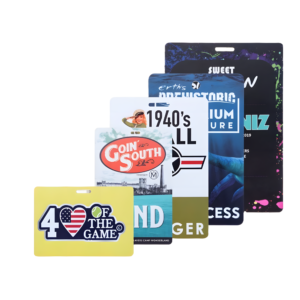
IV. Dual Frequency RFID Badges and Cards
Dual frequency cards are composed of two frequency cards, such as a combination of high frequency card and high frequency card or high frequency card and low frequency card, which can be used in access control systems, bus travel, ID cards, etc.
The characteristic of dual frequency RFID cards is that they can simultaneously read low frequency and high frequency cards, with high security, high efficiency, and multi-functionality, supporting multiple payment methods.
Common types of dual frequency cards:
- Any 2 of LF card, HF card, and UHF card combined, also commonly known as dual frequency card. For example, the combination of low frequency card and high frequency card like ID and MF1 S50, low frequency card and ultra-high frequency card like ID and GEN2, and high frequency card and ultra-high frequency card like MF1 S50 and GEN2.
- The combination of LF card, HF card, and UHF card also commonly known as tri-frequency card. For example, the combination of low frequency card, high frequency card and ultra-high frequency card like ID, MF1 S50, and GEN2.
- The combination of 2 protocols of HF RFID cards, one device should not read two chips in the same composite card at the same time to avoid interference. For example, the combination of ISO 14443 A card and ISO 14443 B card like MF1 S50 and THR1064 dual frequency card, or ISO 14443 A card and ISO 15693 card like MF1 S50 and NXP chip dual frequency card.

